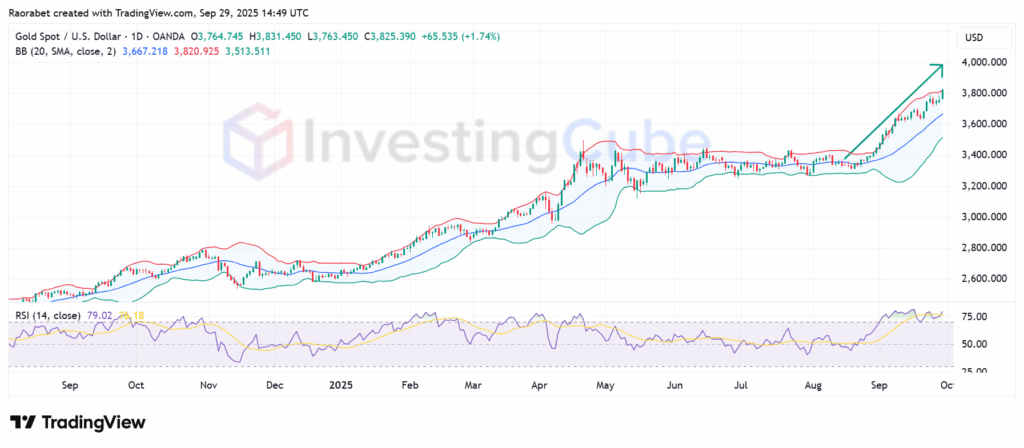- Gold price has been on a hot streak since mid-August and the question is whether the momentum has made $4,000 a valid target in 2025.
Gold has just broken the $3,800-per-pound mark, hitting a new all-time high of $3,831. Expectations of a dovish Fed, a weaker U.S. dollar, high ETF and central bank inflows, and demand for safe havens because of macro uncertainties are all driving the bullish run. But will it get to $4,000?
What’s Driving Gold Price Up?
The Federal reserve cut interest rates for the first time in 2025 in September. As a result, the opportunity cost of owning gold has gone down. This has strengthened gold and made it more appealing than fixed-income assets like Treasury bonds. That said, the Federal Reserve may remain hawkish in response to strong data or inflation shocks. That could lead to rates rising and gold being pressured.
Lower interest rates usually mean a weaker US dollar (USD). Because gold is valued in US dollars, a falling dollar makes the yellow metal cheaper for customers from other countries who use other currencies. This increases global demand and drives up the price.
Investors are turning to gold as a way to cushion themselves against crises because of the higher risk and volatility throughout the world. Another significant pressing issue is the political gridlock in Washington, which could lead to a US government shutdown. This political unrest makes people less sure about the stability of the US economy and financial markets.

Gold price has its daily RSI at 78 and is trading near the upper Bollinger Band, underlining Bullish control. Chart source: TradingView
Is $4,000 In the Cards?
Several major banks now forecast that the journey to $4,000 is a matter of when, not if, as gold is now worth more than $3,800. For example, both Deutsche Bank and J.P. Morgan have raised their predictions for the price of gold, saying that it could rise to an average of $4,000 per ounce by 2026.
Some, like Goldman Sachs, estimate that there is a chance that the price could go up to $5,000 if certain risks, like the Federal Reserve losing its independence, were to happen.
Gold is likely to keep going higher as long as the key factors that drive it. That could be in form of Fed rate policy, geopolitical risk, and central bank demand) staying the same.
There are, however, risks to the rally. A quick correction could happen if the Fed suddenly reverses its recent dovish stance, significant geopolitical crisis calms down, or the US dollar suddenly rises sharply. For now, gold is likely to continue its ascent to new heights, since the factors pushing the price higher seem too strong to be readily reversed.
In Summary
Overall, the perfect combination of safe-haven demand, policy easing, and economic uncertainty has propelled gold to record a run above $3,800. There are a lot of positive predictions, so $4,000 is not out of reach. However, getting there will require dovish policy, high global demand, and the absence of significant surprises.
The surge is driven by strong safe-haven demand due to a weakening US Dollar, expectations of Fed rate cuts, and heightened concerns over potential US government shutdown as well as geopolitical instability.
Yes, some analysts predict $4,000 by 2025-2026, fueled by central bank demand and ongoing uncertainties.
A stronger US dollar, resolved geopolitical issues, or a reversal by the Federal Reserve of its recent dovish policy could cap gold’s gains.


